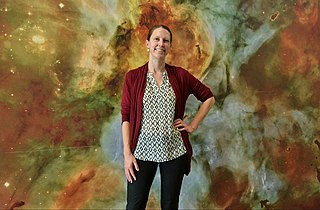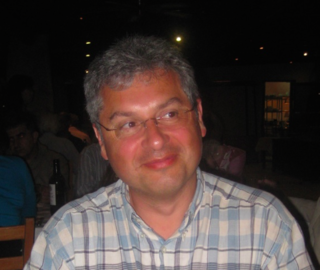Related Research Articles

Sandra Moore Faber is an American astrophysicist known for her research on the evolution of galaxies. She is the University Professor of Astronomy and Astrophysics at the University of California, Santa Cruz, and works at the Lick Observatory. She has made discoveries linking the brightness of galaxies to the speed of stars within them and was the co-discoverer of the Faber–Jackson relation. Faber was also instrumental in designing the Keck telescopes in Hawaii.

Marc Aaronson was an American astronomer.
The Newton Lacy Pierce Prize in Astronomy is awarded annually by the American Astronomical Society to a young astronomer for outstanding achievement in observational astronomical research. The prize is named after Newton Lacy Pierce, an American astronomer.

Bryan Malcolm Gaensler is an Australian astronomer based at the University of California, Santa Cruz. He studies magnetars, supernova remnants, and magnetic fields. In 2014, he was appointed as Director of the Dunlap Institute for Astronomy & Astrophysics at the University of Toronto, after James R. Graham's departure. He was the co-chair of the Canadian 2020 Long Range Plan Committee with Pauline Barmby. In 2023, he was appointed as Dean of Physical and Biological Sciences at UC Santa Cruz.

Associated Universities, Inc. (AUI) is a research management corporation that builds and operates facilities for the research community. It is a not-for-profit 501(c)(3) corporation headquartered in Washington, D.C., United States. The current president is Adam Cohen. The corporation's major current operating unit is the National Radio Astronomy Observatory, which it operates under a Cooperative Agreement with the National Science Foundation.
Amy J. Barger is an American astronomer and Henrietta Leavitt Professor of Astronomy at the University of Wisconsin–Madison. She is considered a pioneer in combining data from multiple telescopes to monitor multiple wavelengths and in discovering distant galaxies and supermassive black holes, which are outside of the visible spectrum. Barger is an active member of the International Astronomical Union.

Alyssa Ann Goodman is the Robert Wheeler Willson Professor of Applied Astronomy at Harvard University, former co-director for Science at the Radcliffe Institute for Advanced Study, Research Associate of the Smithsonian Institution, and the founding director of the Harvard Initiative in Innovative Computing.

William Nielsen Brandt is the Verne M. Willaman Professor of Astronomy & Astrophysics and a professor of physics at the Pennsylvania State University. He is best known for his work on active galaxies, cosmological X-ray surveys, starburst galaxies, normal galaxies, and X-ray binaries.
Lisa Jennifer Kewley is an Australian Astrophysicist and current Director of the Center for Astrophysics | Harvard & Smithsonian. Previously, Kewley was Director of the ARC Centre of Excellence for All Sky Astrophysics in 3-D and ARC Laureate Fellow at the Australian National University College of Physical and Mathematical Sciences, where she was also a Professor. Specialising in galaxy evolution, she won the Annie Jump Cannon Award in Astronomy in 2005 for her studies of oxygen in galaxies, and the Newton Lacy Pierce Prize in Astronomy in 2008. In 2014 she was elected a fellow of the Australian Academy of Science. In 2020 she received the James Craig Watson Medal. In 2021 she was elected as an international member of the National Academy of Sciences. In 2022 she became the first female director of the Center for Astrophysics | Harvard & Smithsonian.
Hyron Spinrad was an American astronomer. His research has ranged from the study of planet atmospheres to the evolution of galaxies. From 2010 until his death in late 2015 he was an emeritus professor of astronomy at the University of California, Berkeley.

Françoise Combes is a French astrophysicist at the Paris Observatory and a professor at the Collège de France where she has been the chair of Galaxies and cosmology since 2014.
Alan Michael Dressler is an American astronomer at the Carnegie Institution for Science of Washington, D.C. Among his works is the popularization Voyage To The Great Attractor: Exploring Intergalactic Space.

Heather A. Knutson is an astrophysicist and professor of planetary science at California Institute of Technology in the Division of Geological and Planetary Sciences. Her research is focused on the study of exoplanets, their composition and formation.
Kristen Sellgren is an American retired astronomer and Professor Emerita at the College of Natural and Mathematical Sciences, Ohio State University. She won the Newton Lacy Pierce Prize in Astronomy in 1990. She is the founder of American Astronomical Society's Committee for Sexual-Orientation & Gender Minorities in Astronomy (SGMA).
Nadia Zakamska is a Russian-American astronomer who is a professor at Johns Hopkins University.
Harriet Dinerstein is an American astronomer. The American Astronomical Society honored her work by awarding her the Annie J. Cannon Prize in 1985. She also received the Newton Lacy Pierce Prize in 1989. Dinerstein received her Bachelor of Science degree from Yale University in 1975 and her Ph.D. from the University of California, Santa Cruz in 1980. She currently is a Professor of Astronomy at the University of Texas at Austin.
Christine D. Wilson is a Canadian-American physicist and astronomer, currently a University Distinguished Professor at McMaster University.

David Elbaz is a French observational astrophysicist specializing in galaxy formation and evolution. He is a Research Director at the Commissariat à l'Énergie Atomique et aux Énergies Alternatives (CEA-Saclay), where he has worked as a researcher in the Astrophysics Division (AIM) since 1994. He led the Cosmology and Evolution of Galaxies laboratory for approximately a decade and has been the managing editor of the journal Astronomy & Astrophysics since 2018.

James Moran is an American radio astronomer living in Massachusetts, USA. He was a professor of Astronomy at Harvard University from 1989 through 2016, a senior radio astronomer at the Smithsonian Astrophysical Observatory from 1981 through 2020 and the director of the Submillimeter Array during its construction and early operational phases from 1995 through 2005. In 1998 he was elected to the National Academy of Sciences, in 2010 to the American Academy of Arts and Sciences, and in 2020 to the American Philosophical Society. He is currently the Donald H. Menzel Professor of Astrophysics, Emeritus, at Harvard University.
Caitlin M Casey is an observational astronomer and associate professor at the University of Texas at Austin. She is known for her work in extragalactic astrophysics; she works on the formation and evolution of massive galaxies in the early Universe.
References
- ↑ Ciolfi, Riccardo; Stratta, Giulia; Branchesi, Marica; Gendre, Bruce; Grimm, Stefan; Harms, Jan; Lamb, Gavin Paul; Martin-Carrillo, Antonio; McCann, Ayden; Oganesyan, Gor; Palazzi, Eliana; Ronchini, Samuele; Rossi, Andrea; Salafia, Om Sharan; Salmon, Lana (2021-12-01). "Multi-messenger astrophysics with THESEUS in the 2030s". Experimental Astronomy. 52 (3): 245–275. arXiv: 2104.09534 . Bibcode:2021ExA....52..245C. doi:10.1007/s10686-021-09795-9. ISSN 1572-9508.
- ↑ "Andrew Blain's Homepage". Archived from the original on 2010-06-07. Retrieved 2010-06-15.
- ↑ "Andrew Blain". The Conversation. 2018-11-14. Retrieved 2024-12-11.
- ↑ "AlmaNorthAmericanScienceAdvisoryCommittee < ALMA < NRAO Public Wiki".
- ↑ "Team | HerMES". Archived from the original on 2011-08-17. Retrieved 2010-06-15.
- ↑ "Newton Lacy Pierce Prize in Astronomy". American Astronomical Society. Retrieved 2024-02-20.
- ↑ Blain, Andrew. "Andrew Blain: ResearchGate". ResearchGate. Retrieved 2024-03-05.